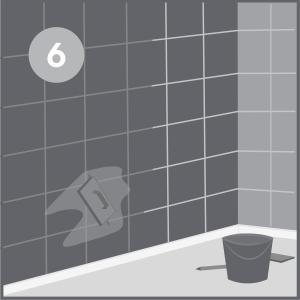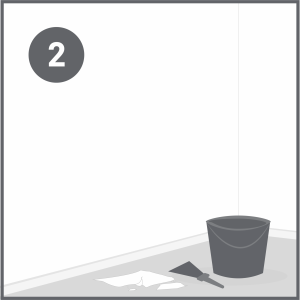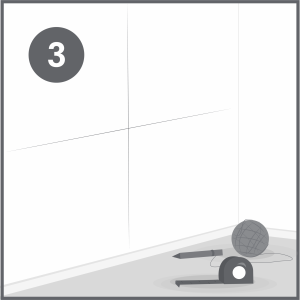Tiles are a great way to update a wall in your home, whether you’re creating a feature wall, tiling a bathroom, or creating a splashback within the kitchen, and when the tiles have been laid correctly, a tiled wall can be stunning.
However, it is important to ensure that you take time to prepare the wall surface and lay the tiles precisely in order to achieve the perfect tiled wall. In this guide, we’ll outline the steps involved in tiling a wall, but if you have any questions don’t hesitate to get in touch and the team will be more than happy to help.
1. Calculate the number of tiles required
Before beginning the tiling process, it is important to plan it out and calculate the number of tiles you require. To do so, you need to work out the dimensions of the wall you will be tiling and the size of the tiles. Often, the product packaging or product description will state the coverage in square metres, so divide the total area of the wall by the coverage area of a box of tiles. Once you’ve got this figure, we’d recommend adding an extra 10% for breakages or cracks, so multiply your number by 1.1 and round up to the nearest whole number.
This can be made a lot easier by using our calculator which is displayed on each product page. Simply enter the dimensions of the wall you are tiling, and the calculator will let you know exactly how many packs of tiles you’ll require.
2. Prepare the wall
The wall needs to be prepared well in order to ensure the tiles can be applied securely and evenly. The first step is to ensure any existing tiles or wallpaper have been removed carefully.
If the wall is left damaged and uneven, or you’re working on a wall that requires waterproof capabilities, such as in a bathroom or wetroom, you may decide to use tile backer boards to create a more even surface.
Once the wall has been cleaned of any debris, prime the wall by adding a PVA adhesive. This can be done using a paintbrush and prevents the plaster on the wall from absorbing the tile adhesive that is applied later on.
3. Decide on the tile layout
Before tiling the wall, you need to decide on the layout of the tiles. Use a tape measure to divide the length and width of the wall and find the centre point of the wall. Draw a horizontal and vertical centre line which will be used as a guide to installing the tiles.
Create a gauge rod
A gauge rod helps to ensure the tiles are laid accurately and evenly. Take a wooden batten and cut it so that it is half the length of the wall. Lay out a line of tiles with tile spacers in between them, and place the wooden batten alongside them, ensuring it lines up with the edge of the first tile. Then mark the positions of the tiles and the gaps between the tiles on the wooden batten, and this will act as a guide for tile installation.
4. Setting out the wall tiles
Hold the gauge rod horizontally onto the wall with the end of the rod sitting at the centre point mark. The gauge rod should reach the end of the wall, but if it doesn’t, mark where the gauge rod ends. If the gap is half a tile or more, you’ll need to cut a tile to fit the gap.
Now position the gauge rod against the vertical centre line, with the end of the rod touching the skirting board or floor, and mark where the top of the gauge rod falls. Then move the rod up so that the bottom is in line with the marked line, and continue until you reach the top of the area that is being tiled. If there is a gap of less than half a tile, move the starting points up slightly, or if it’s more than half a tile, tiles will need cutting.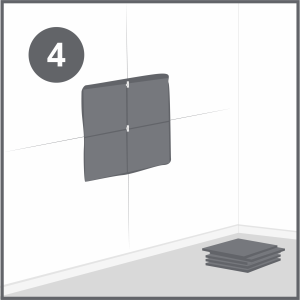
Hold the gauge rod horizontally across the wall, ensuring the top edge is lined up with the starting point mark, and use a spirit level to ensure it is straight. Now draw a straight line across the gauge rod, and use this to act as a guide.
Nail a timber batten horizontally with the top edge lined up with the line you’ve just marked. Hammer the nails part way into the wall, with some of the nail still sticking out. Now nail another timber batten vertically, with the edge lining up with the vertical line. You now have guides and can start tiling the wall.
5. Tiling the wall
Scoop some tile adhesive onto a trowel and apply it to the wall – start at the corner of the timber battens. Spread the adhesive across in horizontal movements, using a notched trowel. Apply the adhesive in areas of around 1 metre squared, as a larger area might mean the adhesive starts to dry before the tiles can be applied.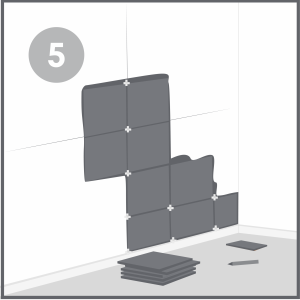
Now place your first tile into the corner of the timber battens, and press the edges against the corners and the whole tile against the wall. Then push another tile into place above it and adjacent to the original tile. Once these 3 tiles are in place, add spacers between the tiles in the corners, and push the tiles firmly together. Then continue the process, adding another tile above the last tile, and adjacent. Continue this method and cover all the tile adhesive, before applying more tile adhesive to the wall and repeating the process.
Leave the tiles to dry, using the time given on the adhesive manufacturer’s instructions, before removing the vertical timber batten – just prise the nails out with a claw hammer. Then repeat the process above to cover the rest of the wall with whole tiles.
Tiling the corners
When tiling corners, the likelihood is that you’ll need to cut tiles to fit in the space. To do so, measure the dimensions of the gap that needs tiling, and cut these dimensions with a tile scribe or scorer. Once the tile has been cut, double-check that it fits into the gap and make any adjustments if required.
Spread a small amount of adhesive onto the back of the tile with a notched trowel, before pressing the tile piece into place.
6. Grouting wall tiles
Now you’ve covered the wall in tiles, the grout must be applied – but make sure the adhesive has had sufficient drying time first.
Before you begin the grouting process, remove the tile spacers at the edges of walls and corners.
Start at the bottom left of the wall, and put a small amount of grout onto the tiles using a trowel. Spread the grout with a grout spreader, using a diagonal upward movement to ensure it passes into the joints between the tiles. Try to do this as quickly as possible to prevent the grout from hardening too quickly, or work in sections.
Once the grout has been applied, wipe a damp sponge over the tiles to remove the excess, but without taking any grout out of the joins.
To create a neat appearance, allow the grout to dry slightly before using a finisher to go along the joints. Then leave the grout to dry, before wiping off the powder film that appears with a clean cloth. Finally, seal the tiles for better long-term performance.